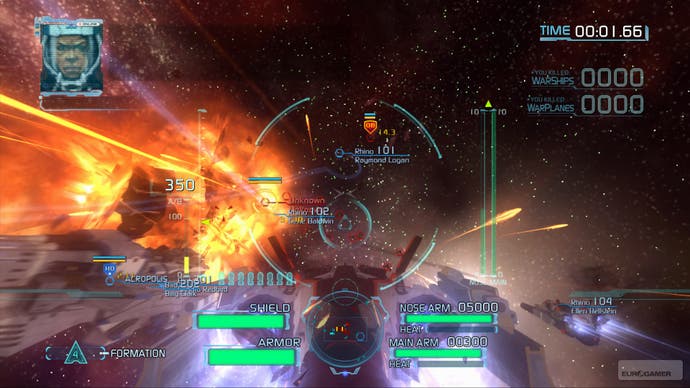Project Sylpheed
Reach for the Stars.
Pressing up on the D-pad orders Katana's squadron mates to form up and focus their attention on the same target but there's just not enough time left. An idea: hold down the Y-button to trigger the special move power bar, which fills at inversely proportional expense to our shield gauge. As this reaches level 2 there are five seconds remaining. Release the button and the screen turns red as all of the ship's shield defence systems congregate at the Rhino's nose. White light and shallow breathing as we smash through the enemy's target's hull: 3 seconds, 2 and did-I-do-it-did-I-do-it?, 1.
Mission Failed. Eurogamer now has carpet burn on its forehead.
While born from the same lineage, Project Sylpheed is not much like the retro games with which it (bar one letter) shares its name. It's best described as Ace Combat in space, a cheap critical shorthand for which we make no apologies as it's almost exactly correct. From the bonkers anime story through to the disorientating, multi-directional control and pad-rattling physics the two games are remarkably close, bar colour scheme, models and, well, gravity and oxygen.
While players who downloaded and tried the 360 Marketplace demo over the last fortnight would be forgiven for thinking the game lacked depth and focus, the full version quickly reveals itself to be, at once, engagingly arcadey and surprisingly deep. It's certainly necessary to work your way through the comprehensive set of training missions which ably teach players how to read the initially baffling HUD, the complex 3D radar, how to resupply from tankers, radio team mates orders as well as some of the aforementioned more advanced techniques. The game provides a huge amount of control to the player but, despite these control complexities, it won't be long before you're speeding around, dissecting your HUD's display in an instant in order to efficiently complete levels to the astonishment of any uninitiated onlookers.
The menu presentation is Phantasy Star-style dated and the average (but skippable) FMV sequences, which tell the tiresome and obvious story off-putting. But where it counts, behind the wheel of a nippy space fighter plane, the game is pretty and exhilarating, offering a white knuckle ride of repetitive but irresistible objectives.

The game's arcade roots are clear from the off. Each of the sixteen levels can be played through multiple times, with a high score leaderboard (local only) showing your best grade and the number of points earned on each. Points are awarded for the number of enemies you've taken down, the weight of those enemies (!?) and the time in which you finished the mission. Points are deducted for friendly fire and for using too many restarts. An alphabetical grade is awarded for each level with a meta-grade for the whole campaign calculated from these individual stats providing ample reason to go back and improve your scores.
Points earned are used to invest in new technology which provides more powerful weaponry to enable you to upgrade your ship and attain higher grades in an upward spiral of progression. Additionally each level has multiple unspecified sub-objectives which, if completed alongside the main objectives, earn extra points and speed up your craft's development.
Project Sylpheed is surprisingly tough, requiring repeated attempts at some levels not only to destroy all of the targets in a level, but also to do it within the strict time limits imposed upon you. As some levels are split into multiple stages, with no opportunity to save in between each section, this can cause the acute frustration described above as you feel compelled to keep pushing on until you complete the final section or else lose all of your hard-earned progress. Likewise, the dearth of online options (there are no online leaderboards and certainly no online Crimson Skies-style dog-fighting matches) ensure the package is far less than it could have been. Nevertheless, the core game is, given a little time and concentration, excellent, if repetitive. Since Sony seems to have long left the Colony Wars series for dead and Nintendo likewise with Rogue Squadron, this game ably fills a gaping whole in one of gaming's most pure and heady genres.








